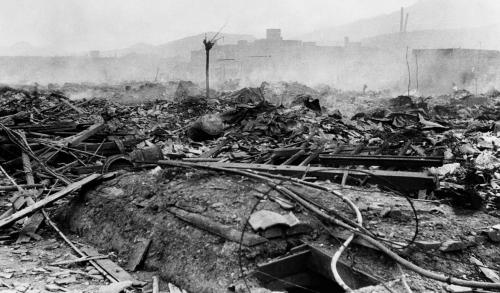Let Nagasaki remain ‘the last city’ to suffer nuclear devastation says museum director as UN chief arrives
It’s essential that Nagasaki’s devastation should “not be forgotten” now or in the future, if the threat of nuclear war is to be lifted, said the Director of the Japanese city’s Atomic Bomb Museum, ahead of a visit there on Thursday by the UN Secretary-General.

The smoldering ruins of Nagasaki, about 700 metres from the hypocentre of the explosion, as seen on 10 August 1945.
António Guterres was in Tokyo on Wednesday where he held talks with Prime Minister Shinzo Abe, as well as meeting the city’s Mayor and atomic bomb survivors, before traveling north to participate in the 73rd Nagasaki Peace Ceremony.
The number of survivors of the bombing of Hiroshima and Nagasaki – or hibakusha as they are known in Japanese, is decreasing each year.
Japan’s health ministry says that as of last March, only 155,000 survivors remain, with 90,000 having died over the past decade. Moreover, the number of survivors directly exposed to radiation in the cities and their surrounding areas, has dipped below 100,000 for the first time, with the average age being 82 years old.
Before the commemoration, Akitoshi Nakamura, Director of Atomic Bomb Museum spoke to UN News.
Having started working at the Museum 60 years after the second atomic bomb was dropped on Nagasaki, just three days after Hiroshima, Mr. Nakamura enthusiastically shared the citizens “high hopes” as they “eagerly” await Mr. Guterres’ arrival.
“We are, from the bottom of our hearts, welcoming the SG’s visit here,” he asserted.
Laying out plans for the Secretary-General’s visit, Mr. Nakamura shared his hopes that the UN chief would join local children in making origami cranes, a symbol of peace, before touring the museum where highlights include a clock that stopped at 11:02 am, when the bomb was dropped; documents charting the catastrophe after the bombing; and the broken belfry dome of the Urakami Cathedral.
“We would like him to see those,” said the curator. “But more than anything, we would like him to see the photos of hibakusha.”
“What is most horrific is the effect of nuclear radiation, so we would like him to see the documents and panels that show the effects of nuclear radiation on health,” Mr. Nakamura elaborated.
The museum traces the catastrophe that unfolded after the bomb.
“We want people to see what a horrific weapon an atomic bomb is, and the kind of devastation over 14,000 nuclear weapons around the world can bring,” Mr. Nakamura stressed, explaining the museum’s aim to eliminate stockpiles of nuclear weapons, by illustrating the horrors they inflict.
“The two atomic bomb museums, in Hiroshima and Nagasaki, are about something that happened in the past, but they also are important in the sense that they trigger an awareness of the danger that nuclear weapons may cause in the future,” he said.
After 73 years, Mr. Nakamura does not want the experiences of the dwindling number of survivors to be forgotten along with them.
Calling it “the most important thing,” he said that “the museums continue telling the story of what happened at the time, in order for it to not be forgotten.”
Hiroshima was the first city to be devastated by an atomic bomb, on 6 August, 1945, and for the time being at least, Nagasaki is the last. With that distinction, Mr. Nakamura spells out “it’s very important to prevent another exposure to an atomic bomb.”
“We, the citizens of Nagasaki, have been appealing to the world to make Nagasaki the last city devastated by an atomic bomb,” he said.
As hibakusha numbers decline, education that carries on their voices becomes ever more important.
Source:United Nations
- 314 reads
Human Rights
Fostering a More Humane World: The 28th Eurasian Economic Summi

Conscience, Hope, and Action: Keys to Global Peace and Sustainability

Ringing FOWPAL’s Peace Bell for the World:Nobel Peace Prize Laureates’ Visions and Actions

Protecting the World’s Cultural Diversity for a Sustainable Future

Puppet Show I International Friendship Day 2020

